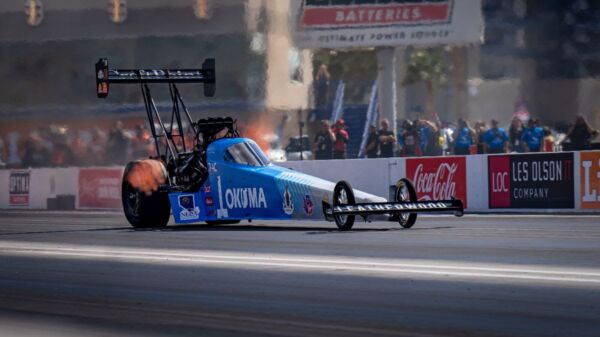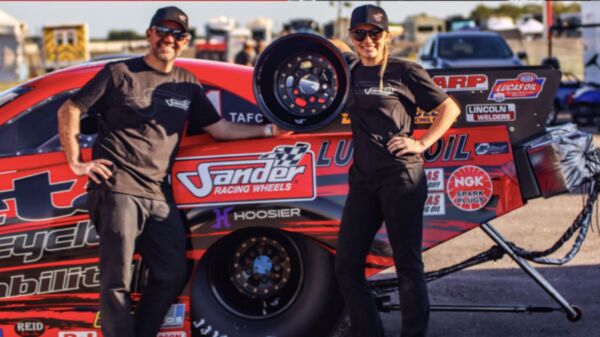The following is the first installment of a 7-part behind the scenes series that takes a look at the inner workings of an upstart NHRA A/Fuel dragster operation in National Event competition.
Adversity
I missed it.
It was September 17, 2017, and the time was 4:51 p.m. I wasn’t nervous. There wasn’t a distraction, no one played games on the starting line, and I don’t have any type of an excuse. I just missed it. It’s been nearly three months and I still think about it every single day…multiple times a day. That’s not a cliché or some type of lip service, it’s a gut ache that won’t go away.
It’s impossible to tally every single waking moment that was spent over the course of the 27 months prior to the 2017 NHRA Carolina Nationals preparing for what needed to happen four-tenths of a second after the tree flashed in the final round, but I’m going to start by first taking a moment to paint a picture of what it’s been like being two brothers taking our lumps, fighting adversity, and getting our first taste of figuring out how to field a nitro car in the NHRA’s quickest and fastest sportsman class.
I feel that in order to accurately reflect the gravity of the situation and what could have been, we first need to document the timeline of events that led MBR to a final-round matchup against Shawn Cowie in our national event debut as car owners.
And that’s where this story begins.
Pre-Race
One of the things that I think makes the early successes that we’ve had so special is the set of circumstances that we’ve had to deal with to get to this point. MBR is a Columbus, Ohio-based operation, but Kyle has lived in Houston the entire time that we’ve owned this car. The only time we had previously made incremental progress towards our goal of getting our car on track was when he was paying to fly back-and-forth from Texas to Ohio, sometimes more than once a month, in order to come back and get this thing put together.
We have a comfortable shop, especially for our purposes, but it’s not built for living in. When he was in town, though, we turned it into a home. We couldn’t afford to waste a moment of preparation over the course of the last two years. When things were coming down to the wire to get ready for our first regional race in Indianapolis, we each took a week of vacation and we stayed at the shop for eight consecutive days. Kyle literally never left the 1,900-square-foot confines of our garage for nearly 200 straight hours. The daily schedule was:
- Wake up at 7 a.m.
- Eat our only meal for the day at 6 p.m.
- Work on the car until 5 a.m. (usually the time we started to lose our minds and couldn’t find the tools that were just in our hands)
- Throw down a foam mat on the concrete floor to sleep
- Repeat
As you could tell from our previous driver blogs chronicling the progress of preparing our car for its debut, Kyle is the man with the plan behind the operation. Where he goes, I go. It’s a team effort in every sense of the word. I will be the first to admit that I am not even close to being on his level from a mechanical standpoint. I’ll put a clutch in it, I’m our resident parts cleaner, and I’ll jump in on any remedial jobs so that he can stay heads down on the bigger picture and more advanced tasks. I live for the opportunity to stand on the gas, but I will help out wherever I can.
 Now, we have enough inventory in the trailer to get our car to the track and to make all seven runs for the weekend…IF we aren’t hurting the wrong parts. We have a complete motor, an extra set of heads, and an underwhelming (but sufficient) inventory of clutch parts. It is fully understood that if we hurt the wrong part, the car is going back in the trailer and we will be heading back to Columbus as soon as the officials will let us out the gate. With that said, we caught our biggest break of the weekend before the race had even begun.
Now, we have enough inventory in the trailer to get our car to the track and to make all seven runs for the weekend…IF we aren’t hurting the wrong parts. We have a complete motor, an extra set of heads, and an underwhelming (but sufficient) inventory of clutch parts. It is fully understood that if we hurt the wrong part, the car is going back in the trailer and we will be heading back to Columbus as soon as the officials will let us out the gate. With that said, we caught our biggest break of the weekend before the race had even begun.
After arriving in Charlotte and setting up our pit area (that’s still the most surreal feeling to be parked next to teams that we’ve looked up to for years), we had to make a gasket call in preparation for Q1 the following morning. Realistically, this is a routine task and we should have been on our way back to the hotel within the hour.
After installing our gaskets, however, our teammate for the weekend, J.P. Gutierrez, diagnosed that one of our recently repaired cylinder heads was .034” shorter than the three other heads that we have. While it took a couple hours to settle on a plan for moving forward, it saved us valuable spare parts. We can’t overemphasize how big of a find that was, but that also meant that we were down to one spare head remaining in the trailer before we even took the car off the jack stands.
Friday
Less than four hours after pulling out of the track, Kyle and I were back in the pits at 6 a.m. before the rest of our crew. We went into that day with a game plan for how we were going to run the car. After burning up the right side cylinder head on both runs at the Indy regional race, we made the call that we were only going to take the car to the 330’ mark in Q1 to make sure that we addressed the issues properly. Returning to the pits after the first run without any parts attrition was even more critical after cycling out the cylinder head from the night before.
We had not run in a National Event in over two years and one of the things that caught me off guard is how much they’ve cut down on the time you are in the staging lanes. When we previously raced with Dreher Motorsports, I would take my time, get in the car 10-15 minutes after we got up there, and there were times that I would still be strapped in for more than 45 minutes before we would make the run.
That is not even close to the case anymore.
We were the first dragster out after the Funny Cars on Friday because I didn’t have any points coming into the event. We left our pit immediately after being called and by the time we stopped in the lanes they had just fired the third-to-last pair of Funny Cars. We’re learning to be fast in everything that we do with this car, but this weekend really forced us to adjust in every aspect from turning the car around in between rounds to getting strapped in in record time.
Q1 – 6.993 @ 128.74MPH
Being on a single is always different for me. In my attempts to treat every run the same, I generally don’t get caught up with who the person is in the other lane, but rather just what type of engine combination they are running so that I know what the staging process needs to be. There have legitimately been times when I’ve backed up from a burnout and not been able to remember who is in the other lane other than it’s a blower car and I need to listen for them to bring the revs up before I go on the high side and bump it in. Having a single, however, just always feels different. I remind myself about no one else being out there with me on a single significantly more than I think about who is in the other lane when I’m paired up with someone.
One of the other problems that we struggled with in Indy was the drivability of the car. The actual  construction of the car is great. It’s more responsive than any car I’ve ever driven, and thanks to a wider and taller roll-cage, and a custom poured seat, it fits Kyle and I like a glove. The issue, however, is that there was a nasty vibration that showed up during Q2 and Q3 in Indy and we had no idea where it was coming from.
construction of the car is great. It’s more responsive than any car I’ve ever driven, and thanks to a wider and taller roll-cage, and a custom poured seat, it fits Kyle and I like a glove. The issue, however, is that there was a nasty vibration that showed up during Q2 and Q3 in Indy and we had no idea where it was coming from.
As you’ll see in the video, once we started the car up and throughout the process of doing a burnout, backing up, and staging, there is some violent vibration that really shakes the camera around. The biggest head scratcher for us was that the vibration was not consistent in when it would show up. Sometimes it happened when the clutch was in, sometimes it happened when the clutch was out…it really would not give us any clue as to what was causing it.
Anyways, onto the run.
Outside of the vibration, the car started fine and did a burnout without any issues. When I attempted to trim the fuel after the burnout to help start building heat in the motor, however, you can hear the motor go real lean in a very short amount of time, and I had to take the car back to the starting line with more fuel going through it than we wanted. For some reason, this car just continues to fight us here, and just like the vibration, it is random in picking when it wants to be an issue.
Over the course of my career driving in both Super Comp and Top Alcohol Dragster, I have made a handful of runs, but probably significantly less than you would think. I continue to find the process of backing the car up after the burnout to be the least enjoyable part of driving. For me, there’s just something inherently awkward about backing up a car with a wheelbase that long. To make matters worse, our radios were going in and out all weekend long while we were on the track and it was 50/50 whether or not we would have to make another correction to straighten the car out when pulling into the beams.
On the run itself, the vibration was at its worst when I let the clutch out to stage the car, just like it was in Indy. Looking at the tree gave the illusion that I was looking at it cross-eyed and I just shifted my focus towards looking for a flash of color. When the car launched, it picked up the front wheels, set them back down, and then picked them back up again and carried them a little ways. At this point, the vibration really hadn’t subsided and my vision was still a little hazy. This began to contribute to a bit of a problem.
The car was about 80ft off the starting line and beginning to drift to the right while the front wheels were still up in the air, but I couldn’t detect it because my vision was still so blurred at that time. You can see in the video that I continued to turn the wheel further to the left because the car wasn’t responding due to the wheels not being on the ground. When the wheels finally settled back down, I was overcorrected and you can see on the NHRA All Access video that the car shot to the left and got a little out of the groove before I was able to bring it back. Needless to say, with everything going on in the car, the 330’ cones came up pretty quick.

——
I was a little frustrated with myself after the run because I knew I didn’t drive the car as well as I am capable of. I was disappointed because I normally don’t have any issues with reading the situation of whether or not the front wheels are in contact with the track before trying to correct the car, and I knew that our efforts to remedy the vibration in the cockpit in between races didn’t improve the situation at all.
The good news, however, was that the motor stayed happy amid all of the chaos and we felt good about taking the car to the finish line for Q2 to attempt to get ourselves into the show.
And with that, Charlotte was underway.
Check out Behind the Ropes Pt. 2, as Corey Michalek details the struggles that MBR faced in Q2 at the 2017 NHRA Carolina Nationals, setting them up for a do-or-die run in the final qualifying session.
This story was originally published on December 17, 2017. 























